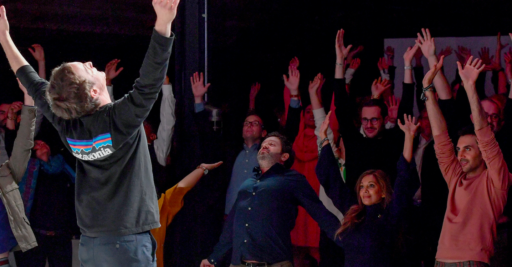Mike Taylor, a Tai Chi & Qigong Master Instructor certified by ATCQA, started his journey with these two healing arts at a young age, learning from his grandfather, a Captain in the United States Navy, as well as from Ken Van Sickle, one of the original students of Cheng Man Ching in New York City.

Mike’s early experiences shaped his understanding of Tai Chi and Qigong as two highly practical and life-enabling practices, that extended well beyond narrowly-defined skills and forms to master. This perspective combined with Mike’s wife and Strala Yoga Co-Founder Tara Stiles’ ground-breaking work in removing dogma and rigidity from yoga, to make it widely accessible to millions of people around the world.
Strala Yoga, which has recently received accreditation from ATCQA for its teaching in Tai Chi, Qigong, and Yoga, stands out by combining the foundational principles of Tai Chi and Qigong with the practice of yoga, focusing on movement and breath in a way that harmonizes and enables the entire body. Taylor explains, “Tai Chi and Qigong are about bringing your whole body together in harmony, so you can be where you are and go where you want to go, both easily and sustainably.” This differs from traditional yoga’s emphasis on poses, which can feel intimidating to newcomers, or impractical for everyday life, including for people working through a variety of health challenges and injury.
The idea to bring Tai Chi and Qigong foundations together with yoga emerged from observing the barriers people face with conventional yoga, while also seeing the wonderful spark that a great variety of yoga forms can bring into Tai Chi and Qigong practice. “We saw a side of yoga that was turning people away because of its rigidity, and emphasis on getting one part of you at a time into a pose that looked right, but didn’t feel right. At the same time, our community was discovering tremendous benefits in a yoga practice that was grounded in Tai Chi and Qigong,” Taylor says.
By bringing Tai Chi and Qigong into yoga, Taylor and Stiles aimed to make yoga more easily adoptable and beneficial to more people. The fluid movements and breathwork of Tai Chi and Qigong allow for an adaptable practice that meets individuals where they are, whatever their current physical condition, mobility, or flexibility happens to be. “Applying the movement and healing foundations of Qigong and Tai Chi to yoga, mountaineering, or even leading a meeting at work, nobody ever gets the sense of ‘That’s not for me,'” Taylor emphasizes.
One of the key aspects Taylor highlights is the shift from rigidity to mobility. “Rather than entering a challenge all rigid and stiff, how about making sure that you’re movable first?” he asks. This philosophy is evident in Strala Yoga classes, where the focus is on ensuring the entire body is mobile and harmonious, before moving into any pose or form. This approach not only enhances physical health and ability, but also promotes mental well-being by reducing stress and increasing mindfulness.

The integration also extends to breathing techniques. In traditional yoga classes, breathing is often treated as something that happens at the same time as movement, but not as something that moves you. In Strala Yoga, this moving and healing relationship between breath and body is central, following the principles of Tai Chi and Qigong that breath guides and enables movement. This results in a practice that feels more natural and less forced. It becomes easier for practitioners to connect with their bodies and minds, and achieve greater challenges with ease and sustainability.
The innovative approach taken by Strala Yoga demonstrates how two different kinds of ancient practices, Tai Chi/Qigong and yoga, can be effectively integrated into wellness routines, and bring everyday real-life benefits to people all around the world. The unique combination of Tai Chi, Qigong, and yoga not only broadens the appeal of yoga, but also establishes it as practical for people of all ages, backgrounds, and abilities. It’s a truly welcoming and healing practice for everyone.
As Taylor aptly puts it, “This is for life. Whether you’re out in the field, on a mountain, trying to study, or dealing with injuries, this practice is about enabling you to do more, and feel better.”